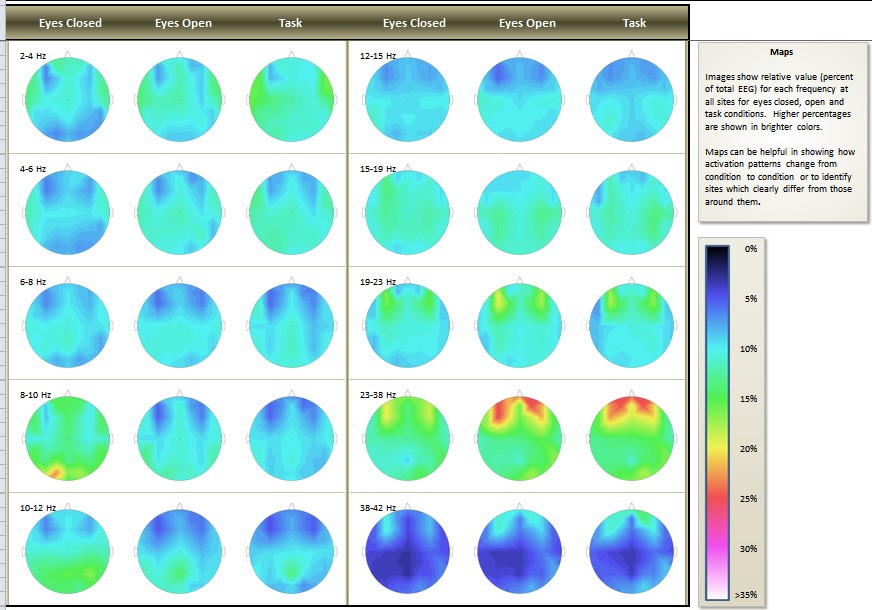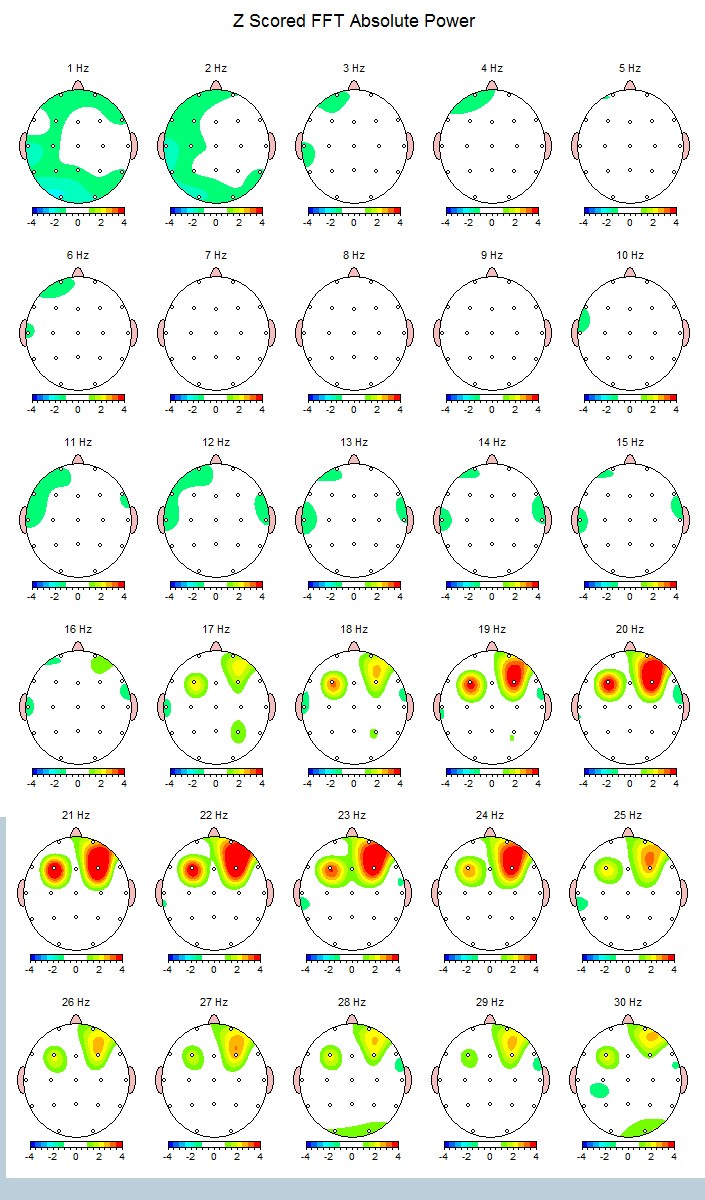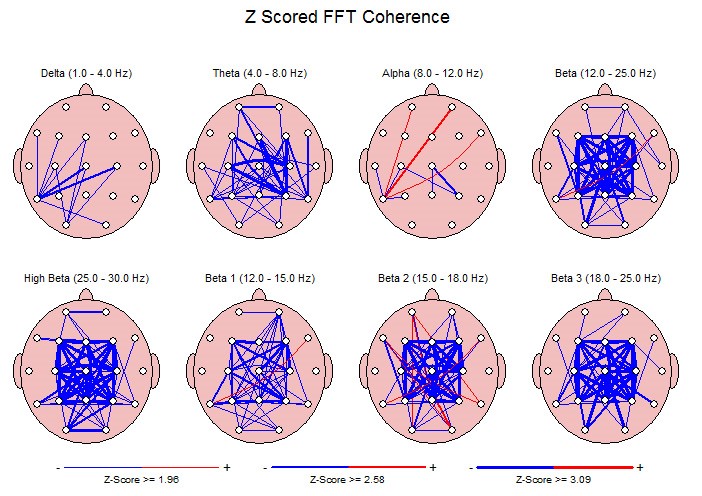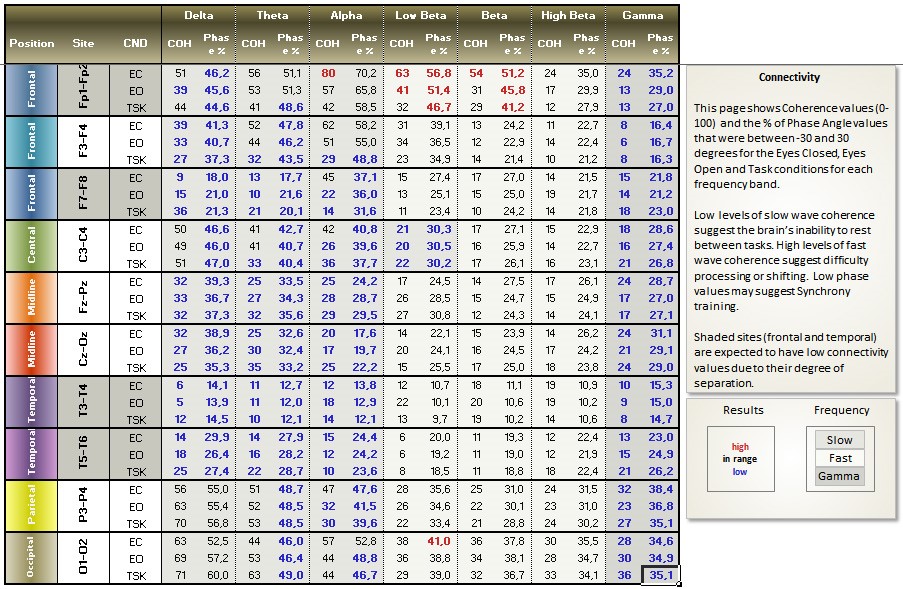Z-scores vs Trainer’s Q
NeuroGuide with Z-scores vs brain-trainer Trainer’s Q (TQ)
QEEG vs. TQ
“First of all I want to express my appreciation and gratitude for Pete’s work and efforts on the TLC7 and the brain-trainer system. I am REALLY convinced of these assessment and training tools and do profit a lot from them in daily neurofeedback practice!
I had formerly been working (and still do) with a BM Discovery device and NeuroGuide a lot – both for QEEG assessments and z-score NFB, which provides a seamless integration of assessment and training as well, but actually based on a population-based normative comparison with average brains and training deviant brain areas towards normal respectively average. I was generally having (and still have) good success with NeuroGuide – however, there have also been cases, which did not really progress well with the training and did not really improve much at all or any further from a certain level of progress. So I encountered that Z-score NFB – as convincing as it may appear to scientifically oriented guys like me – does have some limits and does not bring you forward in every case or with every client.
Therefore I had been seeking for good and useful alternatives and found the TLC7 and brain-trainer system to be worthwhile for having a deeper look into. I have meanwhile been intensively coping and working with the TLC7 and brain-trainer system for about a year and I must say that I really love it!
For me the TLC7 assessment is a very valuable add-on as well as a reasonable alternative to a QEEG-assessment. I found that the TLC7 assessment provides about the same basic picture of a clients’ brain as a QEEG done with NeuroGuide. Of course the information and brain maps of these two assessment methods are not identical but rather similar to each other, but they somehow verify each other in many aspects.
I do for instance have a client with a very hot prefrontal cortex (extremely high beta at Fp1, Fp2, F3 & F4), which especially fires up with eyes open and in task, as seen on the TLC maps page:

Same is shown for the same client in NeuroGuide – here an eyes open assessment. Both assessments (TLC7 and QEEG with NG had been done on the same day right after each other):

NeuroGuide also shows very low coherence values for that client all over the brain and over all frequency bands (except alpha) – here the same eyes open assessment:

About the same is shown on the TLC synchrony page. However, the TLC does also show low Alpha coherence values. Please be aware that the TLC does also show low coherence values in the Beta and High Beta band – but they are not pointed out in blue, because low fast wave coherences are not regarded as an issue:

So seeing about the same things in the TLC7 as in the QEEG done with NeuroGuide does actually prove the validity of the TLC7 and gives me the confidence that I can rely on the data of the TLC7. However, the TLC7 does provide a lot of additional valuable information on a clients’ brain, which is not so directly obvious or not even recognizable at all from the QEEGs done with NeuroGuide. In regard of the above client, the TLC7 did also point out low gamma coherences, left/right reversals (especially in the rear of the brain), front/back reversals, a general fast wave dominance as well as low Theta/Beta ratios all over the brain, a low Alpha peak frequency in the front of the brain, a hot right rear quadrant, low SMR values and even a few more issues. As these are important information for selecting the proper training protocols, I wouldn’t want to miss these any more. Therefore the TLC7 has become an indispensable and extremely valuable assessment and brainwave pattern analysis tool for me.
So even if one is already doing population-based QEEG assessments on his clients, the TLC7 is definitely a valuable addition and worth the according investment, as it provides additional information which are helpful in understanding even better how the brains of your clients function. And for those trainers and clinicians who can’t afford a 10,000 – 20,000 US$ QEEG equipment anyway, the TLC7 is a very good low-cost alternative, which delivers valid and reliable information on the clients brain as well as a population-based QEEG does. Especially for training purposes (unless one is doing z-score training) I regard the TLC7 as even more valuable and useful than a population based QEEG assessment, because it provides a lot of essential information on the client’s brain, that is not found in a QEEG and which is extremely helpful and relevant in regard of an appropriate training protocol selection.
An invaluable feature of the brain-trainer system is the seamless integration between the TLC7 assessment and the neurofeedback training. The TLC7 assessment outputs a training plan with recommended training protocols that are based on the assessment analysis … and the brain-trainer design package includes all necessary training-designs in order to apply the recommended protocols and perform the training plan. I regard this to be one of the most important features of the brain-trainer system, because it reduces or even eliminates the guesswork in regard of what, where and how to train in order to help the clients’ brain to change towards better functioning. The complete handling and usability of both the TLC7 assessment as well as brain-trainer design-package is top-notch and easy to perform for even lay-trainers.
As for the training efficiency, I do achieve the same good (if not even better) results with the brain-trainer system as with z-score training. My clients report (and I can verify this from training myself) that they experience the neurofeedback sessions with the brain-trainer system to be even more intense and efficient than the z-score neurofeedback sessions with NeuroGuide.
Below the line I meanwhile find myself working much more with the Q-wiz and brain-trainer system than with my Discovery and NeuroGuide, although latter had been much more expensive, which would actually be a reason that they should receive more dedication. However – as the brain-trainer system provides the same good (if not even better) training results at just a fraction of my time and efforts that I need to put into 19-channel z-score training (I don’t need to tell that it takes much more time and effort to apply 19 electrodes instead of just 4), I meanwhile REALLY prefer working with the Q-wiz and the brain-trainer system, especially as it also provides the possibility of doing HEG-training for just a relative small additional investment into a nIR-headset.
I do recommend the brain-trainer system to anyone who is looking for an efficient and reliable neurofeedback training system and who can’t or doesn’t want to afford the investment into a clinical grade NFB system. It provides the same good results and usability at just a fraction of the costs … and for those, who do afford the purchase of a 10.000 – 20.000 US$ (or even more) clinical grade system, it is definitely worthwhile to also spend some additional bucks for the brain-trainer system (e.g. the Signature EEG Package 4C Pro or even the Signature Combo Package Pro) in order to being able of acquiring additional information and an alternative view on the clients’ brain as well as for having additional and alternative training options.”
–Claudius Nagel, Germany
http://www.mind-shop.de
***